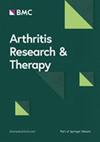TGFβ 信号通路因 HLA-B27 表达而改变,导致脊柱关节炎的致病后果
IF 4.9
2区 医学
Q1 Medicine
引用次数: 0
摘要
HLA-B27与脊柱关节炎(Spondyloarthritis,SpA)的关系已经存在了50年,但至今仍未解释清楚。我们最近发现,在HLA-B27/人β2微球蛋白(hβ2m)转基因果蝇的翅胚盘中表达的HLA-B27通过与I型BMP受体(BMPR1)Saxophone(Sax)发生物理相互作用,从而干扰了骨形态发生蛋白(BMP)通路,导致无交叉脉表型。研究了转基因果蝇翅膀中活化素/转化生长因子β(TGFβ)通路与HLA-B27/hβ2m之间的遗传相互作用。研究人员对翅膀显像盘中与HLA-B27结合的肽组进行了表征。在HLA-B27/hβ2m大鼠(B27大鼠)的肠系膜淋巴结(mLN)T细胞中,评估了HLA-B27与活化素受体样激酶-2(ALK2)、ALK3和ALK5 BMPR1s之间的物理相互作用、其配体诱导的抗断头小母(SMADs)和非经典BMP/TGFβ通路蛋白的磷酸化以及TGFβ通路靶基因的转录水平。在HLA-B27/hβ2m转基因果蝇中,除了BMP通路失调外,通过I型激活素/TGFβ受体巴布(Babo)参与的激活素/TGFβ通路的不恰当信号传导也导致了无横纹表型。我们在HLA-B27/hβ2m转基因果蝇翼像盘中发现了与HLA-B27结合的具有典型结合基序的肽。我们在 B27 大鼠的 mLN 细胞中证实了 HLA-B27/hβ2m 与哺乳动物 Sax 和 Babo 的直向同源物,即 ALK2 和 ALK5(即 TGFβ 受体 I)之间的特异性物理相互作用。在 B27 大鼠的 T 细胞中,SMAD2/3 对 TGFβ1 的磷酸化程度增加,表明 TGFβ 通路失调。相应地,在基础条件下和/或暴露于 TGFβ 后,B27 大鼠 T 细胞中该通路的几个靶基因(包括 Foxp3、Rorc、Runx1 和 Maf)的表达增加。有趣的是,B27 大鼠的幼稚 T 细胞中 Tgfb1 的表达减少,甚至在发病前也是如此,这一观察结果与促炎模式一致。这项研究表明,HLA-B27 改变了果蝇和 B27 大鼠的 TGFβ 通路。鉴于该通路在 CD4 + T 细胞分化和调节中的重要性,它的干扰可能会导致 B27 大鼠中观察到的促炎性 T 辅助细胞 17 的异常扩增和调节性 T 细胞表型的改变。本文章由计算机程序翻译,如有差异,请以英文原文为准。
TGFβ signaling pathway is altered by HLA-B27 expression, resulting in pathogenic consequences relevant for spondyloarthritis
Association of HLA-B27 with spondyloarthritis (SpA) has been known for 50 years, but still remains unexplained. We recently showed that HLA-B27 expressed in wing imaginal disc from HLA-B27/human-β2 microglobulin (hβ2m) transgenic Drosophila deregulated bone morphogenetic protein (BMP) pathway by interacting physically with type I BMP receptor (BMPR1) Saxophone (Sax), leading to crossveinless phenotype. Genetic interaction was studied between activin/transforming growth factor β (TGFβ) pathway and HLA-B27/hβ2m in transgenic Drosophila wings. The HLA-B27-bound peptidome was characterized in wing imaginal discs. In mesenteric lymph node (mLN) T cells from HLA-B27/hβ2m rat (B27 rat), physical interaction between HLA-B27 and activin receptor-like kinase-2 (ALK2), ALK3 and ALK5 BMPR1s, phosphorylation of small mothers against decapentaplegic (SMADs) and proteins of the non-canonical BMP/TGFβ pathways induced by its ligands, and the transcript level of target genes of the TGFβ pathway, were evaluated. In HLA-B27/hβ2m transgenic Drosophila, inappropriate signalling through the activin/TGFβ pathway, involving Baboon (Babo), the type I activin/TGFβ receptor, contributed to the crossveinless phenotype, in addition to deregulated BMP pathway. We identified peptides bound to HLA-B27 with the canonical binding motif in HLA-B27/hβ2m transgenic Drosophila wing imaginal disc. We demonstrated specific physical interaction, between HLA-B27/hβ2m and mammalian orthologs of Sax and Babo, i.e. ALK2 and ALK5 (i.e. TGFβ receptor I), in the mLN cells from B27 rat. The magnitude of phosphorylation of SMAD2/3 in response to TGFβ1 was increased in T cells from B27 rats, showing evidence for deregulated TGFβ pathway. Accordingly, expression of several target genes of the pathway was increased in T cells from B27 rats, in basal conditions and/or after TGFβ exposure, including Foxp3, Rorc, Runx1 and Maf. Interestingly, Tgfb1 expression was reduced in naive T cells from B27 rats, even premorbid, an observation consistent with a pro-inflammatory pattern. This study shows that HLA-B27 alters the TGFβ pathways in Drosophila and B27 rat. Given the importance of this pathway in CD4 + T cells differentiation and regulation, its disturbance could contribute to the abnormal expansion of pro-inflammatory T helper 17 cells and altered regulatory T cell phenotype observed in B27 rats.
求助全文
通过发布文献求助,成功后即可免费获取论文全文。
去求助
来源期刊

Arthritis Research & Therapy
RHEUMATOLOGY-
CiteScore
8.60
自引率
2.00%
发文量
261
审稿时长
14 weeks
期刊介绍:
Established in 1999, Arthritis Research and Therapy is an international, open access, peer-reviewed journal, publishing original articles in the area of musculoskeletal research and therapy as well as, reviews, commentaries and reports. A major focus of the journal is on the immunologic processes leading to inflammation, damage and repair as they relate to autoimmune rheumatic and musculoskeletal conditions, and which inform the translation of this knowledge into advances in clinical care. Original basic, translational and clinical research is considered for publication along with results of early and late phase therapeutic trials, especially as they pertain to the underpinning science that informs clinical observations in interventional studies.
 求助内容:
求助内容: 应助结果提醒方式:
应助结果提醒方式:


